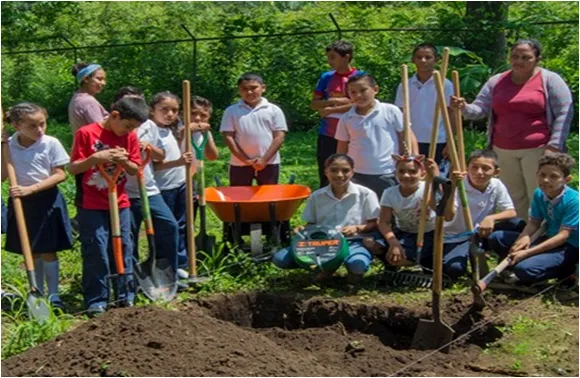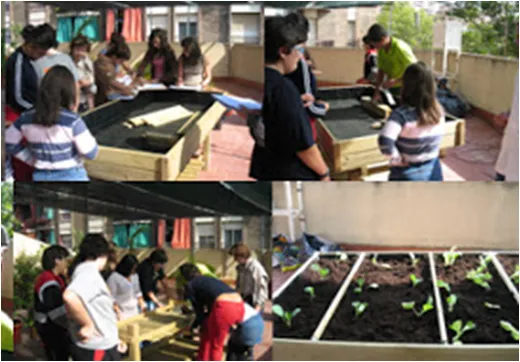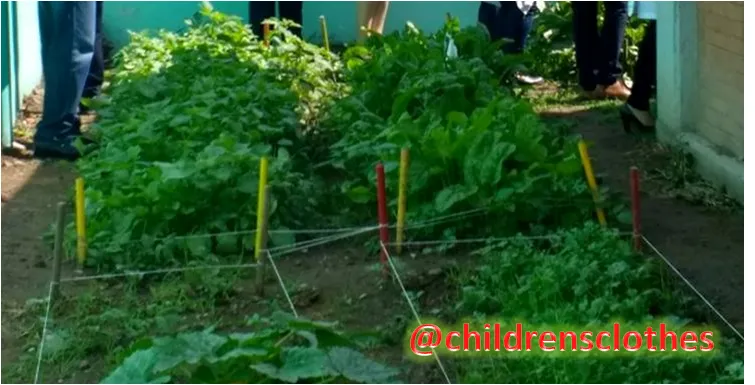We are making alliances with the project of @sc-v and its GREEN FOOTPRINT campaign, and we are preparing manuals which will be taught to the schools via email, so that the people in charge are trained at the moment of doing the work of creating a school garden, this due to the economic and social crisis that our country presents, we have created this incentive that adds value to the lives of the youngest and their families.
WHAT IS IT TO CREATE A SCHOLAR ORCHARD?
Managing a school garden not only requires knowledge of horticulture, but also skills to work with people and common sense.Creating an ecological garden is a multidisciplinary activity that stimulates and motivates students in their day to day. In this show we show some basic steps, useful to design an ecological garden from scratch. The work during the course of students and teachers will turn this space into an educational tool that promotes environmental respect, awareness of responsible consumption and healthy eating and promotes teamwork and camaraderie.


The school has always talked about objectives, projects, interdisciplinarity, sequencing, procedures, contents, attitudes, values and norms. And now comes a revolution with the ecological school garden. Although the school is a reflection of society, it must avoid being immersed in the precipitation of society itself.
The family can participate. It can be an excellent door of dialogue between teachers and mothers and fathers. The grandparents recover the protagonism and contribute knowledge. Immigrants do not feel excluded and even have the work of the garden closer than our children.
The garden has entered the schools and has been a revolution. It is a safe place where children can experience directly with life, with nature. Where they can still enjoy the connection that we as an animal species have with the land that is our home. Success was assured.
Three skills for school gardens
«You just have to know three things to successfully manage a school garden:
- How to motivate people,
- How to grow the plants, and
- To whom to go to ask for help. »
(Guy et al., 1996)
Who will be responsible for the garden?
The "head" or "head" of the garden can be the school principal, an experienced teacher or an experienced farmer in the community. A small group that brings together commitment, interest, experience, authority and contacts should support the person in charge: for example, the school principal, some parents, other members of the community, students, an inspector, health workers or the school custodian. . Later, a wider network of collaborators can be developed.
The garden manager should be able to have a colleague to replace him when necessary. It is also a good idea to have an executive team of older students who are able to carry out the tasks without much supervision.
Basic tools to start:

Hoe: to dig and crumble the earth, lift furrows and clean unwanted grasses.
Rake: to remove and smooth the soil, collect dry leaves and crumble the earth.
Shovel: to remove, flip and aerate the soil and compost.
Wheelbarrow: to transport earth, sand, rubbish, stones and compost.
Hoses or showers: for irrigation.
How large will the orchard be?
The garden can range from the size of a gardener to
the one of a field. The size will depend on the available space. Yes
the school does not have adequate grounds, perhaps there is a space
in the communal gardens or in the badlands along
the road or the roads.
The size also depends on the objectives if education is the main purpose, no matter the space; a few plants are sufficient for experimental observations, for example to study germination. A single 1 x 2 m flowerbed
will produce a very small amount of food. Three or four small stonemasons will provide a model domestic garden for demonstration purposes. Much more space will be required if what is desired is to produce more food or offer professional training in agriculture.
Gardening gloves: to work with the tools.
A good cleaning after each use helps to keep the tools in good condition and to prolong their useful life.
Choosing the seeds and seasonal plants: Choosing the seeds correctly is fundamental, since they will determine the development and growth of the plant. To achieve all the objectives of an ecological garden and connect with the land and the traditions of each area, we must use local varieties that, moreover, adapt better to the soil and help to conserve biodiversity. There are sowing calendars that help to know what to grow in each season.
How do we sow in the school garden?
If they are grains, such as corn or beans, they are sown directly in the soil. If it is coriander, tomato, paprika, or others, it is made in seedbeds, and then transplanted to a definitive place (barbecue, soil), when they have three to four leaves and their stem is well consistent.


• Harvested fruits can be used in the school canteen.
• Children take care of the garden and grow the products. This is motivating and encourages the creation of an orchard at home.
• If the products are not used at school, they can be sold in the community and use the proceeds to maintain the garden and buy materials for the school.
• Children learn a trade that can serve them for the future and allows them to contribute to the fight to minimize pollution, by learning how to make the composter (where the fertilizer is prepared).




How to get people to value the orchards?
The support of people depends on attitudes. In some areas there is a long tradition of enthusiasm for family horticulture. People want their children to learn to grow food, flowers and trees. The horticultural activities that are planned to be carried out will benefit from the positive image that the horticulture has in the community. However, horticulture is often seen as a
hard and dirty work, and not as an education job. In the worst case, the school can be accused of subjecting children to low-paid agricultural work. If that were the attitude, one of the main tasks would be to change it. In this manual we will talk about many ways to give a good image to the garden, for example, interesting families, giving education an essential function, creating a sense of pride and showing that horticulture It can improve our health and our economic situation.
The biggest advantage of these efforts is that for children to grow and produce delicious foods is an exciting and rewarding activity.
Reference:
FAO. 2000. Mejorando la nutrición a través de huertos y granjas familiares. Manual de capacitación para
trabajadores de campo en América Latina y el Caribe. Roma. http://www.fao.org/docrep
/v5290s/v5290s00.htm
Guy, L.A., Cromell, C. y Bradley, L.K. 1996. Success with school gardens: how to create a learning
oasis in the desert. Phoenix, Arizona, Estados Unidos, Arizona Master Gardeners Press en cooperación con
la Universidad de Arizona.
Contact Data.
In addition we will have channels available for questions, suggestions and personalized attention through email and discord.
vastgaocasademodas@hotmail.com
xioreromero@gmail.com or chat with @childrensclothes#7556 on our Discord
You can also enjoy updated information on events and models from our Aurora collection, follow the Instagram account: Vastagocasademodas.
We accept payments in Cryptocurrencies Steem, Sbd.
Why support @childrensclothes?
By supporting this productive social program will be contributing to a solidarity project for children in Venezuela who have no shelter, food and medicine, will be strengthening the productive apparatus and the ability to generate jobs to mothers head of households, will also contribute to maximize the level educational with training for entrepreneurs in various trends, financial, commercial, business, personalized courses, will also be promoting the inclusion of special children Autism, Down syndrome, and children with cancer that occupy a special place. Preventive measures to care for the environment The use of the blockchain will be established as a technology with purpose, and to empower leaders in action to form their own companies, in a self-sustaining model through efficient resource management.
"If society improves, it will improve the performance of the company. You can not be happy alone, I can not do well in the middle of a failed society "
FASHION WITH PURPOSE: THE BEST COAT, IT'S LOVE
YEAR 2019. The goal is to enjoy childhood in all its colors, aromas and flavors.
We thank our collaborators:
@fundition,@adollaraday, @pennsif


